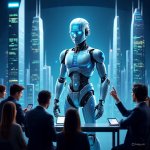In today’s fast-evolving world, artificial intelligence (AI) is no longer a concept of the future—it’s shaping our lives in real time. From chatbots and recommendation algorithms to driverless cars and automated surgeries, AI is transforming every industry it touches. But with this rapid progress comes a pressing question: Is AI a threat to human jobs or a necessary evolution for society?
The Fear of Job Displacement
The biggest concern surrounding AI is job loss. Automation is replacing tasks once performed by humans—cashiers, data entry clerks, customer service representatives, even certain types of journalism. A 2020 report by the World Economic Forum predicted that AI could replace 85 million jobs globally by 2025. That number is staggering and feeds into the fear that humans may eventually become “obsolete.”
Blue-collar workers aren't the only ones affected. AI is making strides in fields like medicine, law, finance, and even art—fields once considered immune to automation. The concern isn't just about losing jobs, but about the nature of work itself changing so drastically that many people may be unprepared for it.
The Case for Necessary Evolution
Despite these fears, AI is also creating opportunities. While it may replace certain jobs, it is also expected to create 97 million new roles, especially in areas like AI maintenance, programming, cybersecurity, data analysis, and more. Instead of eliminating jobs, AI often shifts the nature of work, automating repetitive tasks and freeing up humans to focus on more strategic, creative, and interpersonal responsibilities.
AI also boosts productivity and innovation. In healthcare, AI can analyze scans more accurately and faster than doctors. In agriculture, it predicts crop yields and reduces waste. In finance, it detects fraud in milliseconds. These advances benefit society at large and lead to higher efficiency and better services.
The Human Element Can’t Be Replaced
Despite AI’s capabilities, it lacks emotional intelligence, moral judgment, empathy, and intuition. No matter how sophisticated AI becomes, it cannot truly replace human values, leadership, ethics, or the creativity that comes from lived experience. Teachers, therapists, artists, and many other roles require a human touch that AI cannot emulate.
The Way Forward: Adaptation and Regulation
Rather than resisting AI, society must adapt. This means re-skilling and up-skilling the workforce, integrating AI into education systems, and creating safety nets for displaced workers. Governments and companies must take responsibility to ensure a smooth transition, not just economically but ethically as well.
Regulation is also crucial. Unchecked AI could lead to exploitation, inequality, and misuse of data. Responsible development, transparency, and global cooperation are essential to ensure AI serves humanity, not threatens it.
Conclusion
AI is both a threat and a tool, depending on how we choose to handle it. It's not the technology itself, but our readiness to adapt, learn, and lead with compassion that will determine whether AI becomes a destroyer of jobs or a catalyst for human progress. The future of work isn’t man versus machine—it’s man with machine.
The Fear of Job Displacement
The biggest concern surrounding AI is job loss. Automation is replacing tasks once performed by humans—cashiers, data entry clerks, customer service representatives, even certain types of journalism. A 2020 report by the World Economic Forum predicted that AI could replace 85 million jobs globally by 2025. That number is staggering and feeds into the fear that humans may eventually become “obsolete.”
Blue-collar workers aren't the only ones affected. AI is making strides in fields like medicine, law, finance, and even art—fields once considered immune to automation. The concern isn't just about losing jobs, but about the nature of work itself changing so drastically that many people may be unprepared for it.
The Case for Necessary Evolution
Despite these fears, AI is also creating opportunities. While it may replace certain jobs, it is also expected to create 97 million new roles, especially in areas like AI maintenance, programming, cybersecurity, data analysis, and more. Instead of eliminating jobs, AI often shifts the nature of work, automating repetitive tasks and freeing up humans to focus on more strategic, creative, and interpersonal responsibilities.
AI also boosts productivity and innovation. In healthcare, AI can analyze scans more accurately and faster than doctors. In agriculture, it predicts crop yields and reduces waste. In finance, it detects fraud in milliseconds. These advances benefit society at large and lead to higher efficiency and better services.
The Human Element Can’t Be Replaced
Despite AI’s capabilities, it lacks emotional intelligence, moral judgment, empathy, and intuition. No matter how sophisticated AI becomes, it cannot truly replace human values, leadership, ethics, or the creativity that comes from lived experience. Teachers, therapists, artists, and many other roles require a human touch that AI cannot emulate.
The Way Forward: Adaptation and Regulation
Rather than resisting AI, society must adapt. This means re-skilling and up-skilling the workforce, integrating AI into education systems, and creating safety nets for displaced workers. Governments and companies must take responsibility to ensure a smooth transition, not just economically but ethically as well.
Regulation is also crucial. Unchecked AI could lead to exploitation, inequality, and misuse of data. Responsible development, transparency, and global cooperation are essential to ensure AI serves humanity, not threatens it.
Conclusion
AI is both a threat and a tool, depending on how we choose to handle it. It's not the technology itself, but our readiness to adapt, learn, and lead with compassion that will determine whether AI becomes a destroyer of jobs or a catalyst for human progress. The future of work isn’t man versus machine—it’s man with machine.

